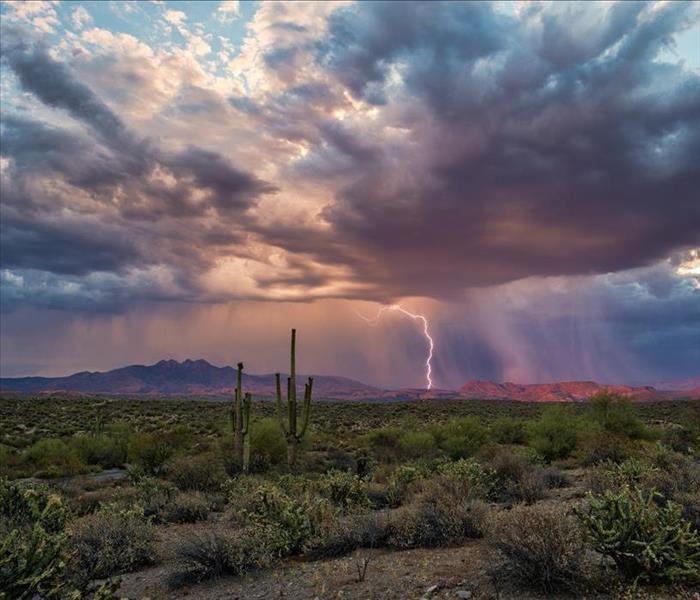Is Your Home Ready for Monsoon Season?
3/2/2021 (Permalink)
Protect Your Home from Flood Damage
Rain conjures up images of splashy puddles, the pitter-patter of droplets on a windowsill, hot cocoa, and a warm fire. But, there can be too much of a good thing. That same rain can ruin the foundation of your house and cause extensive flood damage. It’s important to take precautions before an expected flood to ensure that minimum loss is sustained. If your home happens to lie in a flood zone, here are some flood preparation tips to consider:
1. Install Sump Pumps
Invest in quality sump pumps. When water reaches a certain level, sump pumps spring into action and drain the water to a designated drainage area. There are two kinds of sump pumps available: battery-operated and the kind that can be plugged into your power source. It’s a smart idea to get both because when an area gets flooded, the power is the first thing to go.
2. Elevate Your Electrical Components
Get a licensed electrician to elevate your electrical components. This will include circuit breakers, switches, sockets, and general wiring. The recommended height is 12” above the projected flood elevation for your home. Not only does this prevent sparks, a short circuit, electric shock, or fire, it also keeps your expensive equipment safe and protected.
3. Waterproof Your Basement
The basement is the first place where water collects if it hasn’t been waterproofed. Make sure you clean all the drains and gutters of leaves and debris. Your property should be on a slope that leads water away. All the windows and openings should be sealed.
4. Have Practice Drills
Just like a fire drill at school, it’s important to have a flood drill at home. Make a checklist of the things that need to be checked and done when a flood hits. This checklist should be in a place with ease of access and high visibility, like on the fridge. Everyone in the house should know the list inside out.
Some important things to include on the list would be:
- Turn off and unplug all electrical appliances.
- Turn the electricity off from the main source.
- Turn the gas off from the main source.
- Turn off the main supply of water. Water pipes can burst from pressure in flood situations and add to the floodwater.
5. Make Sure You Have Backflow Valves for all Sewage Connections
All appliances and installations with a connection to the main sewage line, like sinks, washing machines, and toilets, should be installed with a backflow valve. The pressure of the floodwater can cause sewage lines to overflow. Without a backflow valve, this water is going to find an outlet in your home through these installations. Floodwater can be nasty enough to clean without adding sewage to it.
6. Install Septic Pump Alarms
This alarm lets you know when the septic tank is in danger of overflowing. If the tank is flooded, do not flush the toilet before you’ve had an expert take a look at it. Putting additional pressure on a tank that is already flooded may cause the tank to overflow into your home.
7. Secure Fuel Tanks
Any fuel container outside of the house should either be brought in and secured or tied and secured to something outside. If not properly anchored, these tanks could float downstream and damage a neighbor’s property, contaminate a food source, or even catch fire.
8. Have a Supply of Drinking Water
It may seem like there’s an endless supply of water everywhere, but don’t drink water from your well or the city water supply until the water has been tested and declared safe. Have a backup supply of bottled water or invest in a filtration system for your home. You should also have an emergency supply of food and a fully stocked first aid box.
9. Create a Makeshift Toilet System
Septic tanks are most likely to be unusable in a flood situation. It’s important to have a back-up system in case this happens. A Porta Potty can be used in this situation. A second option is to turn off the valve to the toilet tank, line it with sanitation liners or trash bags, and use the toilet as usual. Tie the bags with secure ties, and double or triple bag them to keep flies and smells to a minimum.
10. Move Valuables to Upper Floors
Any valuable and fragile goods that are most likely to sustain irreparable damage from floodwater should be transported to the upper floors of the house. If your house floods, these items will likely be safe from the water.
11. Use Sandbags and Plastic Sheets
Sandbags can soak up water quickly, and plastic sheets can ensure that water doesn’t seep into the foundation of the house. In a pinch, both can deliver quick results. Use sandbags to block water from seeping under the doors.
Flood damage in the monsoon season is a sad reality that millions of people face every year. Despite the best precautions, there is no guarantee against flood damage and water damage. Call SERVPRO of Cedar City/Fillmore, and we’ll take care of any water or flood damage your house sustains. Contact us today, so you can make the best of the rainy season.



 24/7 Emergency Service
24/7 Emergency Service
